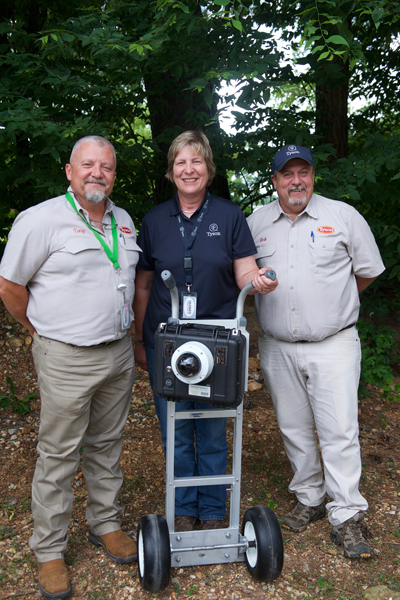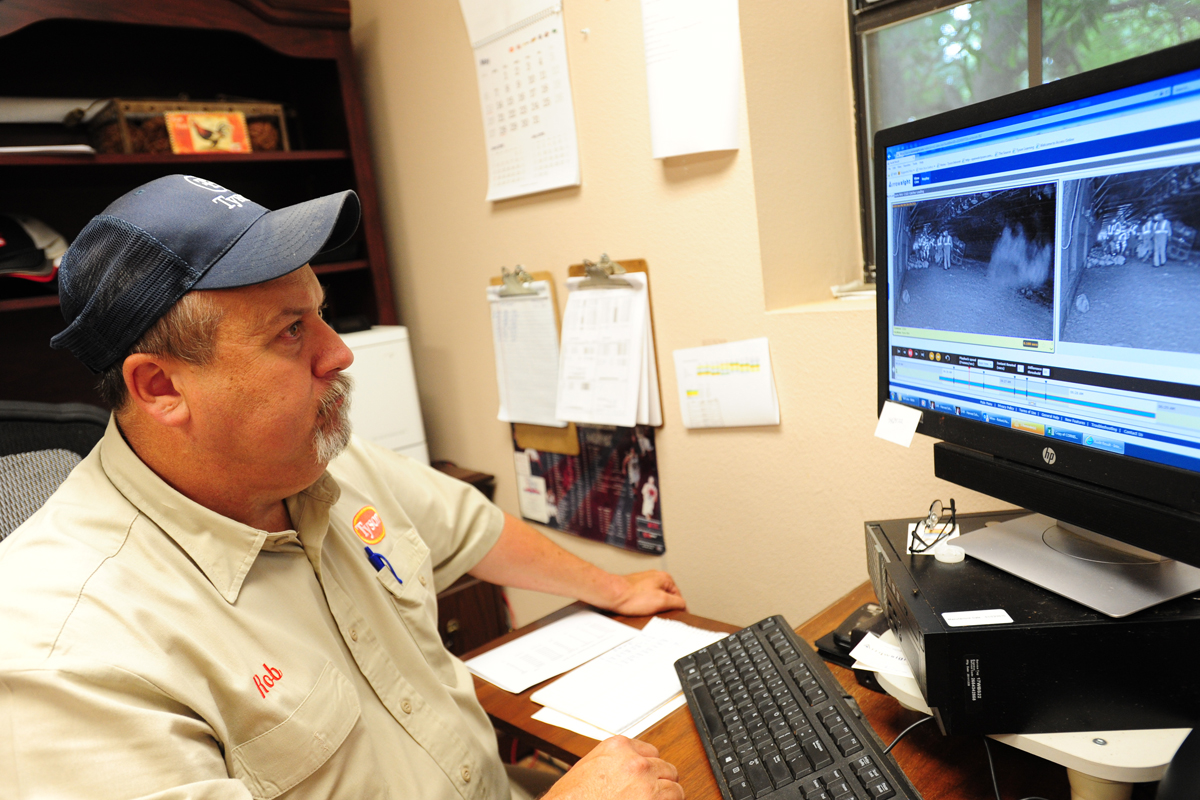Meat processing and packing plants began to use remote video auditing (RVA) from Arrowsight in the early 2000s. CEO Adam Aronson began his work in the meat industry in 2002. The company launched its first pilots in 2004, and those would become the services now offered in processing and packing plants around the world. Arrowsight’s RVA applications include risk mitigation within animal welfare, food safety, quality bio-security, worker safety and margin applications such as yields, throughputs and labor optimization.
Until now, these third-party auditing services had been offered through stationary cameras strategically placed inside the plant and audited by professionals at an Arrowsight network operations center, but now through a partnership with Tyson Foods, RVA has evolved and moved outside the plant.
Development
The partnership on the development of a mobile RVA system started almost two years ago and has been very hands-on throughout. The new mobile RVA technology allows contract catching crews to take RVA with them wherever they go, as well as provide Tyson the means necessary to improve efficiency and take advantage of “coachable” moments, both positive and negative.
Mobile RVA provides a tremendous amount of information and opportunity to make all operations better and more efficient. However, the focus of the partnership on the initial foray into the technology remains on animal welfare regarding the live side catching and transport of chickens.
The first iteration of hardware for the mobile RVA came in the form of a body camera. Contract catchers wore a harness that housed a mobile camera. Catchers found the harness cumbersome and difficult to deal with considering the nature of catching chickens and the environment they worked in. Once Tyson informed them of the issues, Arrowsight came back with a new design.
Arrowsight sent executives to Springdale, Arkansas, for a week to work through the second design of the mobile RVA hardware. The second design consisted of a camera connected to a dolly. The unit was self-contained, the camera protected, and a metal box for a tablet were housed on the dolly without any delicate parts exposed to weather or the rigors of chicken catching. Physically the dolly system worked well, but the tablet needed to boot up, crews needed some training and occasionally the tablet didn’t work. So, Tyson and Arrowsight worked together through a third iteration of the mobile RVA camera, which is what crews currently use.

“You can’t really simulate too much. You’ve got to get out in the field and work with it and empirically discover what the weaknesses are and go back and solve them and get back after it again,” says Mark Moshier, president and COO of Global Industrial & Agribusiness Solutions with Mount Kisco, New York-based Arrowsight Inc.
Arrowsight did its best to construct the final product from off-the-shelf parts easily attainable on the market. The only exception was the custom lithium ion battery pack need to power the unit.
“You’ve got a lot of weight concerns and when you’re running an infrared camera, it pulls a lot of energy,” Moshier says. “To get through a full shift of work, keep the camera at a manageable weight and maximize durability, there was quite a bit of engineering in the customized battery pack.”
Current camera
Similar to the second-generation hardware, the current camera is a self-contained unit, but the size and mobility make it more conducive to the catching environment and considerably more user friendly for the crews. A box able to withstand harsh environments with military-grade fittings houses the camera and the software. Heavy magnets allow for attachment to a hand truck for the catching, and a fork truck for transport to the trailer.
Tyson’s live haul operations office houses the camera bank set up by Arrowsight, and each crew takes two cameras out per trip, one for the hand truck to view the catching, and one for the fork truck to view transport from the house to the trailer. Once back at live haul, cameras are docked for power and communications cords are connected. Once this is done, Arrowsight has access to all video recorded on that camera.
In the chicken house and on the fork truck, the video stays clear and will switch to infrared if light quality isn’t sufficient. Currently Tyson uses the mobile RVA cameras just in the Springdale complex. Five contract catching crews operate in the complex. While one set of cameras goes out with the crew another set is docked for audit and charging, totaling 10 cameras for the complex. Tyson plans to continue rolling mobile RVA out within its big bird business unit.
Game film
Once cameras are docked at the camera bank, Arrowsight begins its audit. Arrowsight chooses an agreed upon number of minutes from the day’s footage to audit and flags “potential occurrences.” Potential occurrences represent what auditors believe to be a problem or opportunity for improvement.
Rob Hulse, live haul manager for the Springdale complex, receives an email citing potential occurrences from the audited footage with the video and a time stamp of the occurrence. He views the video and decides whether he agrees with Arrowsight, in which case he will use the video to coach, or if he disagrees he will inform Arrowsight with the reasons for disagreement, which helps train Arrowsight’s auditors in Tyson protocol.
Once Hulse identifies coachable moments, he brings them to the attention of the crew chief and crew members. How he and Tyson, and the contract catching crews and crew chiefs deal with coachable moments depends on the potential occurrence and the people involved.
“There have been both good and bad coaching moments, it’ll usually work out,” Hulse says. “I ask my catch crews to be their best and to help everybody else be their best. It’s about the teamwork. We look at it as a team and then we refer back to the coaching.”
Mobile RVA possesses the potential to increase bottom line, improve worker safety and a host of other things that come from auditing the video of processes, and Tyson’s Springdale complex invites all those attributes, but according to Karen Christensen, Ph.D., senior director of animal wellbeing, North American operations, improving humane handling remains the primary purpose.
“One gentleman was brought in for coaching and he didn’t correct,” Hulse says. “I went to his crew chief and he was taken out for a while. He came back and got better. To this day, he continues to come in and check in, and he is now a champion of animal wellbeing.”
“And that’s how you change the culture,” Christensen says.

The actual audit
Auditing for chicken catching, or worker safety, or asset management doesn’t require special training that differs from in-plant auditing. Arrowsight clients provide the company with operating procedures, rules and their own training and Arrowsight trains its auditors accordingly.
“As long as we know what the client values and the work rules and what they’re doing, we have a road map that we follow as we’re doing the auditing process and giving feedback, so it doesn’t matter if it’s a construction site, or a factory or a farm,” Moshier says.
Sometimes special circumstances present themselves, and other sources offer insight into training auditors, and what audits should look like. Arrowsight does have a wealth of experience in auditing many industries, including food processing.
“There are some clients that will say, ‘we know you have a lot of experience, you’re in a lot of these environments, what would you recommend?’ Then of course you’ve got your NAMI guidelines and trade organizations have a lot to offer as far as what they would recommend, or what’s important. Sometimes respected experts that work for the clients or that are contractors will give us good insights and the client good insights,” Moshier adds.
Moshier goes on to say auditor training can come in several ways and from several sources, but the client’s expected outcome really determines how Arrowsight audits.
“The outcome you want defines your criteria, and then the criteria define your audit process,” he says.

The future of RVA
Arrowsight constantly looks to push RVA forward. It’s gone from the plant into the field/farm and plans to go further with new innovations and technology. Two possibilities on the horizon include artificial intelligence (AI) and sensory technology to supplement in-plant and mobile RVA. While the company does not currently offer these technologies, the company is invested in these options for the future.
“We are very carefully, and with a lot of planning, focused on probably the most prominent 5 percent of our audit software for moving into an AI situation,” Moshier says. “What we’re really looking at initially is animal welfare applications.”
Moshier says AI would be applied to those areas of production and farming in which clients have historically seen things go wrong or the areas that have caused them the most problems, such as egregious behavior captured on undercover video.
“AI is a big push for us,” he says. “That’s the next frontier, but to do it in a smart and pragmatic way, where it’s not just a feel good, but it actually has the greatest potential to make a more impactful difference.”
Another future addition to the RVA and mobile RVA equipment will be sensors. Arrowsight will make available sensor packages to go with the camera boxes that might include geo-fencing. Clients and auditors will have the ability to track crews through the GPS sensors on the cameras on the farm and through the barns, etc. Some of the GPS sensors available can track to within 10 yards.
“Additionally, we’re going to be adding sensors to those boxes so when they’re in an environment you might be able to pick up something like ammonia level in the house or wind velocity, humidity, temperature,” Moshier says. “There’s all types of sensors out there that are getting better and better. So, there’s going to be innovative sensor packages added to all this mobile gear, so you can couple environmental data along with your visual data, and maybe audio down the road.”

